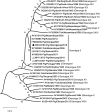Replication and virulence in pigs of the first African swine fever virus isolated in China
- PMID: 30898043
- PMCID: PMC6455124
- DOI: 10.1080/22221751.2019.1590128
Replication and virulence in pigs of the first African swine fever virus isolated in China
Abstract
African swine fever (ASF) entered China in August 2018 and rapidly spread across the entire country, severely threatening the Chinese domestic pig population, which accounts for more than 50% of the pig population worldwide. In this study, an ASFV isolate, Pig/Heilongjiang/2018 (Pig/HLJ/18), was isolated in primary porcine alveolar macrophages (PAMs) from a pig sample from an ASF outbreak farm. The isolate was characterized by using the haemadsorption (HAD) test, Western blotting and immunofluorescence, and electronic microscopy. Phylogenetic analysis of the viral p72 gene revealed that Pig/HLJ/18 belongs to Genotype II. Infectious titres of virus propagated in primary PAMs and pig marrow macrophages were as high as 107.2 HAD50/ml. Specific-pathogen-free pigs intramuscularly inoculated with different virus dosages at 103.5-106.5 HAD50 showed acute disease with fever and haemorrhagic signs. The incubation periods were 3-5 days for virus-inoculated pigs and 9 days for contact pigs. All virus-inoculated pigs died between 6-9 days post-inoculation (p.i.), and the contact pigs died between 13-14 days post-contact (p.c.). Viremia started on day 2 p.i. in inoculated pigs and on day 9 p.c. in contact pigs. Viral genomic DNA started to be detected from oral and rectal swab samples on 2-5 days p.i. in virus-inoculated pigs, and 6-10 days p.c. in contact pigs. These results indicate that Pig/HLJ/18 is highly virulent and transmissible in domestic pigs. Our study demonstrates the threat of ASFV and emphasizes the need to control and eradicate ASF in China.
Keywords: African swine fever virus; animal study; pig; transmission; virus isolation.
Figures







Similar articles
-
Characterization of an African Swine Fever Virus Field Isolate from Vietnam with Deletions in the Left Variable Multigene Family Region.Viruses. 2024 Apr 7;16(4):571. doi: 10.3390/v16040571. Viruses. 2024. PMID: 38675912 Free PMC article.
-
Evaluation of the Deletion of African Swine Fever Virus E111R Gene from the Georgia Isolate in Virus Replication and Virulence in Domestic Pigs.Viruses. 2024 Sep 23;16(9):1502. doi: 10.3390/v16091502. Viruses. 2024. PMID: 39339977 Free PMC article.
-
Persistent domestic circulation of African swine fever virus in Tanzania, 2015-2017.BMC Vet Res. 2020 Oct 1;16(1):369. doi: 10.1186/s12917-020-02588-w. BMC Vet Res. 2020. PMID: 33004025 Free PMC article.
-
[African swine fever in Russian Federation].Vopr Virusol. 2012 Sep-Oct;57(5):4-10. Vopr Virusol. 2012. PMID: 23248852 Review. Russian.
-
The Epidemiology of African Swine Fever in "Nonendemic" Regions of Zambia (1989-2015): Implications for Disease Prevention and Control.Viruses. 2017 Aug 23;9(9):236. doi: 10.3390/v9090236. Viruses. 2017. PMID: 28832525 Free PMC article. Review.
Cited by
-
Immunogenicity Analysis and Identification of Potential T-Cell Epitopes in C129R Protein of African Swine Fever Virus.Microorganisms. 2024 May 24;12(6):1056. doi: 10.3390/microorganisms12061056. Microorganisms. 2024. PMID: 38930438 Free PMC article.
-
Identification of Two Linear Epitopes on MGF_110-13L Protein of African Swine Fever Virus with Monoclonal Antibodies.Animals (Basel). 2024 Jul 1;14(13):1951. doi: 10.3390/ani14131951. Animals (Basel). 2024. PMID: 38998063 Free PMC article.
-
Clinical sequencing uncovers the genomic characteristics and mutation spectrum of the 2018 African swine fever virus in Guangdong, China.Front Vet Sci. 2022 Aug 19;9:978243. doi: 10.3389/fvets.2022.978243. eCollection 2022. Front Vet Sci. 2022. PMID: 36061106 Free PMC article.
-
Transcriptome view of a killer: African swine fever virus.Biochem Soc Trans. 2020 Aug 28;48(4):1569-1581. doi: 10.1042/BST20191108. Biochem Soc Trans. 2020. PMID: 32725217 Free PMC article. Review.
-
Current State of Global African Swine Fever Vaccine Development under the Prevalence and Transmission of ASF in China.Vaccines (Basel). 2020 Sep 15;8(3):531. doi: 10.3390/vaccines8030531. Vaccines (Basel). 2020. PMID: 32942741 Free PMC article. Review.
References
MeSH terms
LinkOut - more resources
Full Text Sources
Other Literature Sources
